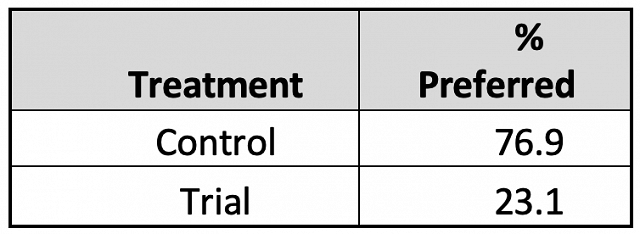LalVigne Mature Foliar Spray with Virginia Merlot (2014)
Matthieu Finot
King Family Vineyards
Abstract
Purpose: To test the sensory effect of Lallemand Lalvigne Mature Foliar Spray on Merlot. Methods: Several rows of a single block of Merlot were treated, per recommended dosages, with Lalvigne. The entire block was harvested (Figure 1) and processed identically but with the treated and untreated fractions separate. Both were fermented in t-bins with Premier Cru (100g/bin) and racked to identical Sansaud A M 36mo. 2012. Results: Triangle testing indicated a significant (p<0.05) perceptible difference between the control and trial groups (Figure 2). Further tasting data (n= 13) showed a preference for the control group (Figure 3). Discussion: The data provides valuable sensory analysis needed to help maintain a balance between vineyard interventions and winemaking. A beneficial avenue of future research may be similar experimentation in “bad weather” years. This may provide the end consumer with enough data for a true cost/benefit analysis. Conclusion: Lalvigne had a discernable sensory impact on the finished wine as compared to the control.
Presented January 28, 2015 at Trump Winery
Keywords: Lallemand, Lalvigne, veraison, Merlot, methoxypyrazine
LalVigne Mature with Merlot
Introduction:
To test the sensory effect of Lalvigne Mature (Lallemand) on Merlot. LalVigne is an organic yeast derivative product applied at verasion as a foliar spray. Two applications are used, one at 5% verasion and another 10-12 days following the first. The purpose of LalVigne is to more closely tie together phenolic and enological maturity by encouraging the concentration of aroma precursors and impacting the timing of phenolic maturity. Additionally, some evidence shows that LalVigne may also reduce methoxypyrazine levels in grapes prior to harvest.
Methods:
Several rows of a single block of Merlot were treated, per recommended dosages, with Lallemand Lalvigne Mature. The entire block was harvested (Figure 1) on the same day with the treated and untreated fractions separate. They were de-stemmed, but not crushed and separated in to tbins. Both were inoculated with Premier Cru (100g/bin). Following the completion of AF both bins were pressed identically but separately and then racked to identical Sansaud A M 36mo. 2012 barrels.
Figure 1.

Results:
Triangle testing indicated a significant (p<0.05) perceptible difference between the control and trial groups (n=25). Taste preference data (n= 13) showed a preference for flavor profile of the control group (Figure 2).
Figure 2. Preference

Discussion:
Additional sprays, or spray programs in the vineyard are usually a question of balance between time, money, effectiveness, and necessity. An enormous amount of data must go into this decision making process, however, each situation is entirely unique so the data is almost never directly applicable.
The data gathered here helps to provide valuable information that can be used in the decision making process. Sensory analysis should be a large consideration in decisions that attempt to maintain a balance between vineyard interventions and winemaking.
In this case, the Lalvigne product had a discernable impact on the finished wine, but with no absolute preference for the trial or the control. As the numerous variables in the vineyard change from year to year and between varietals, it will be interesting to see the sensory effect, if any of Lalvigne. Continuing and expanding research with this product could provide valuable information and insight.
Additional testing with Cabernet Franc, a popular Virginia varitetal that is known for being high in methoxypyrazine, would be an important experiment to perform in this area.
Conclusion:
Though the Lalvigne had an impact on the finished wine in this case, it could prove a valuable tool in various harvest weather, time, and quality scenarios. Its availability to winemakers could help to assure the best quality of fruit possible each year.
References
